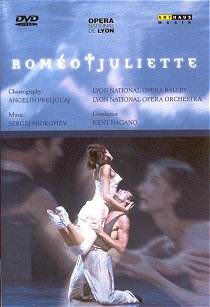This is the third version of Prokofiev’s great ballet
I have now seen on DVD – and immeasurably the best, even if it is sliced
and cut to less than half its usual length. Warner have already issued
the Nureyev production, classical and conservative in style and design,
and suffering from the most lugubrious account of the music I have yet
heard. It reminds one of wading through treacle. A horrendously cheap
DVD release on Video Land Klassik (with just four chapters supporting
more than two-and-a-half hours of music) purportedly dates from 1938
– yet is in such splendid colour (and sound) that this simply cannot
be the case. It is, however, beautifully conducted, coming nearest to
Nagano in setting almost ideal tempi for this work.
Watching this Arthaus release after either of those
DVD performances is likely to prove both rewarding and shocking. Rewarding,
because Nagano’s approach to the score is incendiary, with palpable
electricity lighting up the inherent darkness of the production at every
turn. Shocking, because this is the darkest imaginable vision of a great
love story stripped naked and then weighed down by a post-war, almost
apocalyptic, view of a Europe torn apart by hatred and ethnic cleansing.
The Montagues and Capulets are more akin to the warring factions of
Bernstein’s West Side Story than Shakespeare’s warring European nobility,
and there is more than a suggestion of fascist thuggery operating very
close to the surface of this gut-wrenching production.
Angelin Preljocaj agreed to create this production
for Lyons Opera on the condition that he could use a considerably foreshortened
score, a decision principally taken so the music would sit more comfortably
with a ballet told as a political and emotional parable. However, in
achieving this the scenes have been moved around in a bizarre fashion:
in Scene 3, for example, No.35 (Romeo decides to avenge Mercutio’s death)
appears before No.34 (Mercutio Dies). In the Third Act we have No 31
(incorrectly identified in the booklet as No 32) – Tybalt meets Mercutio
– misplaced when what we really have is Juliet with the ghosts of both
(in otherwords, No 44).
This complexity does not diminish the sheer audacity
of the production values, however, evidently coloured by the backgrounds
of both the designer and the choreographer. Those designs, by Enki Bilal,
a former Yugoslavian comic book illustrator, are principally drawn in
a bleak Berlinesque landscape of inescapable walls. They mimic in many
ways the eclectic design that Fritz Lang brought to his 1920s film Metropolis,
and there is also in this production an emphasis on the futuristic –
particularly illustrated by the pseudo robotic nurses who hive around
Juliet. With monochrome colouring, a pervasive illusion of darkness,
and a threnody of extraneous sound (such as helicopter rotor blades)
this is both everyone’s nightmare and someone’s depiction of a police
state in action.
In choreographic terms this production is a millennium
away from the staid artistry of Nureyev and Kasatkina/Vasilov. This
is, of course, very classical ballet – and in all three productions
it is difficult to separate the movements used in both Juliet’s Funeral
and the Death of Juliet, so similarly are the dancers matched in movement
between the different productions. However, when you look at how Preljocaj
has choreographed the Dance of the Knights – for once aggressive, and
not at all like the chessboard movements we always seem to see – you
can feel the abstraction which this choreographer brings to modern dance.
Entire bodies become balletic, even if the movements are predominantly
minimalist. Rather than an all-embracing fluency of movement the division
of labour is stark: Romeo and Juliet have a swallow-like freedom, whereas
the guards and nurses have an automaton, almost mechanical presence.
Generally this is a superbly danced performance – Pascale
Doye and Nicolas Dufloux tangible and emotive as the lovers. Nagano
grips the score with a vice, and the playing is both lithe and exciting.
Controversially, and given the passion of the playing, it is almost
sacrilegious that Juliet’s death should occur after the music has finished.
It is my only real point of contention in what is otherwise a superb
production.
Marc Bridle
See also
S
& H Dance Special – live and on DVD (PGW
& MB)
Coverage of the Rambert Dance Company begins a short overview
of ‘the art of dance’.
Rambert Dance Company 75th
Anniversary Autumn Programme 1, Sadler's Wells, London, November 2001
(PGW)


